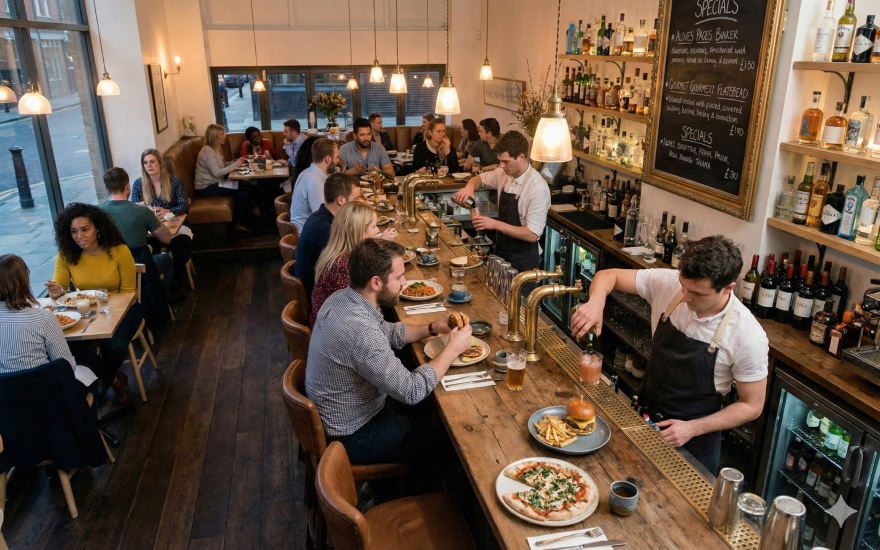Increase Profitability: Link People and Inventory Management

The intersection of people management and inventory management technologies is often overlooked in restaurants. However, integrating a people operating system with an inventory management platform can significantly benefit restaurants, hospitality groups, and foodservice businesses.
Working in foodservice can be physically demanding and stressful. For staff, there's the intense and fast-paced workload, irregular hours, increased customer expectations, and the perception of limited advancement opportunities.
For managers, staffing challenges, employee management, constant budget worries, and financial and operational demands pose extreme threats to a calm professional life.
As foodservice-specific software and platforms see rapid adoption today, the positive effects of restaurant tech like people management and inventory management emerge. The foundational benefits of both these technologies include eliminating tedious and time-intensive tasks, improving employee productivity and morale, and decreasing employee stress.
The Value of a People Operating System
Software as a Service (SaaS) people management platforms, some of which specialize in the unique needs of restaurant businesses, offer an integrated suite of features that help restaurateurs manage their employees, from recruitment and onboarding through training and professional development.
With a people operating system like Push, operators can easily tackle food service challenges like staff scheduling, high turnover, labor shortages, overtime calculations, and regulatory and compliance issues.
Productivity & Job Satisfaction: The People & Inventory Management Connection
What is the connection between people management and inventory management platforms? Employee productivity and job satisfaction. These technologies automate employees' typically manual, profit-draining, and frustrating tasks.
The benefits of coordinating a people operating system like Push with an inventory management platform like MarketMan include:
More Accurate Staffing and Scheduling
By coordinating people operating systems like Push with back-of-house productivity platforms like MarketMan, operators can proactively and accurately forecast customer demand to align staffing and inventory levels. During peak hours or periods with high demand (think Valentine’s Day), these systems can automatically schedule more staff to manage customer volume and order more ingredients to meet inventory requirements. This prevents understaffing or overstaffing and over- and under-ordering inventory to ensure maximum efficiency and profitability.
Real-Time Data
Integrating these platforms allows for better insights into the correlation between staffing levels and inventory usage. Based on historical inventory trends and customer behavior, businesses can analyze data to decide when and how many staff members are needed.

Reduced Food Waste
A collaborative tech stack can help avoid food waste by adjusting staffing and production levels according to real-time demand. If there's a sudden drop in demand, both systems can trigger a reduction in food production, staff hours, and an adjustment in supplier orders – minimizing food waste.
Efficient Training and Onboarding
People management platforms can provide insights into employee skill sets, certifications, and training progress. When aligned with inventory management, this helps managers schedule staff training to ensure efficient operation and reduce errors. Consider the effect of consistent portion sizes on inventory levels and menu profitability.
Better Communication Between FOH and BOH
Inventory management can facilitate seamless communication between FOH and BOH. Proactive alerts built into an inventory management platform can instantly communicate this to FOH managers and waitstaff to adjust the menu (or menu recommendations) on the fly.
Stressless Inventory Ordering
Integrating inventory management and people management platforms can automate inventory ordering, eliminating ad hoc purchasing interruptions. When inventory levels reach a predefined threshold, an inventory management platform can automatically generate purchase orders or alert relevant staff members to restock items. There’s no need to disrupt a manager’s schedule to put out an “inventory fire.”
John Geddes, Director of Sales at East Coast Storage Equipment, highlights the importance of seamless inventory solutions:
"Advanced inventory systems, paired with efficient storage solutions, ensure that restaurants can maintain optimal stock levels without disrupting operations. Whether it's automated pallet racks or modular shelving, having the right infrastructure supports smoother workflows and reduces unnecessary interruptions in a fast-paced industry like foodservice."
Improved Customer Experience
When staffing levels are aligned with inventory and customer demand, the overall guest experience improves. Adequate staff availability ensures prompt service and reduces wait times, while well-managed inventory guarantees that customers can order their desired (and profitable) dishes.

Regulatory Compliance
In industries like foodservice, compliance with labor laws, health and safety regulations, and Federal, State, and City mandates is crucial. Collaborative restaurant tech platforms can help manage employee certifications and ensure staffing and inventory practices comply with relevant regulations.
Leveraging the Power of a People Operating System with Inventory Management
A people operating system like Push and an inventory management platform like MarketMan offer businesses in the restaurant and hospitality industries the opportunity to optimize operations, reduce costs, enhance both employee and customer satisfaction, and make more data-driven decisions based on profitability.
For more infomation on how Push works with MarketMan’s inventory management platform, schedule a demo with a Push expert.
Learn about MarketMan’s Suggestive Ordering feature and how it helps operators more accurately forecast customer demand, inventory demand, and inform subsequent staffing and scheduling decisions.



